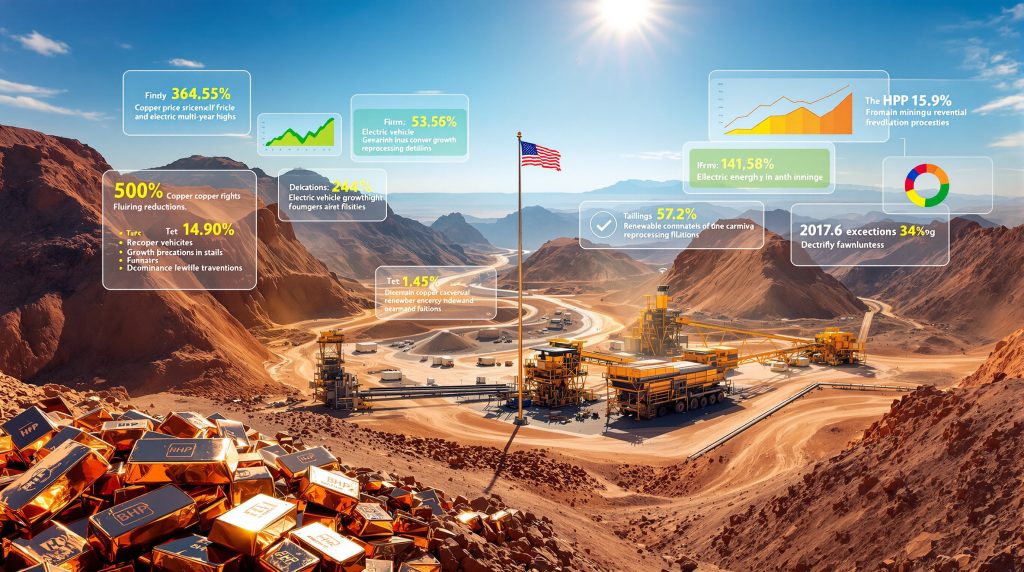Understanding BHP's Strategic Pivot in Arizona's Copper Landscape
Mining giant BHP is reconsidering dormant copper assets in Arizona as a convergence of favourable market conditions transforms previously uneconomical projects into viable opportunities. The BHP reopening defunct Arizona copper mines initiative has gained momentum following the $140 billion company's exploratory activities in the Globe-Miami district, where four inactive mines await potential revival after decades of dormancy.
This strategic reconsideration stems from copper price predictions reaching elevated levels driven by global electrification demands and mounting supply chain security concerns. The energy transition requires substantial copper infrastructure, with electric vehicles demanding three to four times more copper than conventional vehicles and renewable energy systems requiring extensive grid connectivity solutions.
Key Market Forces Driving Revival:
- Elevated copper pricing above sustainable production thresholds
- Supply chain diversification away from geopolitically sensitive regions
- Domestic mining preference policies enhancing project economics
- Critical mineral designation improving regulatory pathways
Policy Transformation Under Current Administration
The Trump executive order on minerals has created unprecedented opportunities for major operators to reassess shuttered assets. BHP CEO Mike Henry characterised the shift in government policy as breathtaking, highlighting the transformation in regulatory attitudes toward extraction industries.
According to Henry, the administration's ambitious approach regarding critical minerals aligns with broader strategies to secure resources and compete with China. This supportive stance toward mining operations represents a fundamental departure from previous regulatory frameworks that often created development barriers.
Policy Framework Changes:
| Regulatory Area | Traditional Approach | Current Environment |
|---|---|---|
| Permit Processing | Extended review cycles | Expedited pathways available |
| Import Competition | Market-driven pricing | Tariff protection measures |
| Federal Coordination | Agency fragmentation | Streamlined oversight |
The implementation of tariffs on copper imports has improved the economics of domestic production. However, the Trump tariffs global impact suggests legislative approval would provide greater long-term certainty compared to executive orders. This policy shift has prompted BHP to increase exploration efforts specifically in Arizona, where geological conditions favour copper extraction.
Globe-Miami District Asset Portfolio
The Globe-Miami mining district represents one of Arizona's most historically productive copper regions, containing four previously operated facilities that BHP shuttered decades ago. This region has established infrastructure and proven geological reserves, reducing the capital requirements compared to greenfield development projects.
BHP has initiated fresh exploratory drilling in the area, indicating serious consideration of asset revival. The Arizona copper revival efforts include both traditional mining operations and tailings reprocessing opportunities, which could provide faster paths to production while addressing environmental remediation requirements.
Globe-Miami District Characteristics:
- Four dormant extraction facilities with existing infrastructure
- Historical production data confirming resource viability
- Tailings deposits suitable for modern reprocessing techniques
- Strategic location within established mining jurisdiction
The district's infrastructure, while requiring modernisation, provides significant cost advantages over completely new developments. Access roads, power transmission capabilities, and water rights already exist, reducing the complexity of project development timelines.
Tailings Reprocessing as Strategic Advantage
Modern extraction technologies have made tailings reprocessing economically attractive, offering BHP multiple strategic benefits. This approach allows copper recovery from previously discarded materials whilst simultaneously addressing environmental legacy issues from historical operations through mine reclamation innovations.
Tailings reprocessing requires lower capital expenditure compared to conventional mining operations and faces reduced regulatory complexity since environmental impact assessments can focus on remediation benefits rather than new disturbance areas. The process typically achieves faster permitting approval and shorter development timelines.
Tailings Processing Benefits:
- Reduced environmental footprint through waste remediation
- Lower infrastructure development requirements
- Simplified regulatory approval processes
- Faster timeline to production compared to greenfield projects
- Potential for continuous operation whilst exploring traditional mining
The Globe-Miami area contains substantial tailings volumes from decades of historical copper production, representing a significant resource base for modern extraction techniques. Advanced flotation and hydrometallurgical processes can recover copper that was previously uneconomical to extract using older technologies.
Resolution Copper Project Complementary Strategy
BHP's partnership with Rio Tinto on the Resolution Copper project represents a separate but complementary approach to Arizona copper development. This joint venture has attracted substantial investment and demonstrates the company's long-term commitment to the region despite current legal challenges.
The Resolution Copper project was specifically discussed during Henry's August meeting with President Trump, indicating high-level political engagement on the development. Furthermore, this project currently awaits court decisions before proceeding with full development activities.
Resolution Copper Project Details:
- Joint venture structure with Rio Tinto
- Advanced permitting stage with environmental assessments
- Potential to become North America's largest underground copper operation
- Estimated multi-decade mine life with substantial production capacity
- Significant infrastructure investment already committed
The project's scale and scope position it as a cornerstone development for domestic copper supply, whilst the Globe-Miami revival strategy provides more immediate production potential through existing asset rehabilitation.
Economic Viability Assessment Factors
The combination of higher commodity prices, supportive policy frameworks, and technological advances has fundamentally altered the investment thesis for domestic copper production. These converging factors create compelling economics for reviving previously shuttered operations and align with broader US copper investment insights.
BHP reopening defunct Arizona copper mines primarily derives strategic value from the company's shift toward copper due to rising demand patterns. This diversification reduces concentration risk whilst positioning the company for energy transition market growth.
Economic Drivers Supporting Revival:
- Sustainable copper pricing above production cost thresholds
- Tariff protection providing competitive advantages over imports
- Reduced regulatory compliance costs through streamlined processes
- Advanced extraction technologies improving recovery rates and reducing operating costs
- Federal procurement preferences for domestically sourced materials
The economics become particularly attractive when considering the reduced capital intensity of rehabilitating existing assets compared to developing entirely new mining operations. Infrastructure modernisation costs are typically substantially lower than greenfield development requirements.
Alignment With Global Copper Demand Evolution
The electrification of transportation systems, renewable energy infrastructure expansion, and data centre proliferation are driving structural copper demand growth. BHP's strategic copper focus positions the company to capitalise on this demand transformation whilst reducing exposure to geopolitical supply risks.
Demand Growth by Sector:
| Application Area | Copper Intensity Factor | Growth Trajectory |
|---|---|---|
| Electric Vehicle Manufacturing | 3-4x conventional vehicles | Accelerating adoption rates |
| Grid Infrastructure | High connectivity requirements | Renewable integration demands |
| Data Centre Development | Substantial power infrastructure | Cloud computing expansion |
This demand growth occurs simultaneously with supply constraints from traditional producing regions, creating favourable long-term pricing dynamics for domestic production. The supply-demand imbalance particularly affects high-grade copper sources, making tailings reprocessing and asset rehabilitation increasingly attractive.
Technical Challenges in Asset Revival
Reopening decades-old mining operations requires comprehensive technical assessment and infrastructure modernisation programmes. BHP reopening defunct Arizona copper mines must evaluate equipment condition, geological changes since closure, and environmental considerations before committing to full-scale operations.
The company's current exploratory drilling programme aims to update geological understanding using modern exploration techniques. This work provides crucial data for assessing resource quality, quantity, and extraction feasibility under current technological and economic conditions.
Technical Revival Requirements:
- Comprehensive infrastructure assessment and modernisation planning
- Updated geological surveys incorporating advanced exploration methods
- Environmental baseline studies for current conditions
- Workforce development programmes for specialised mining skills
- Modern safety protocol implementation exceeding current regulatory standards
Equipment modernisation represents a significant consideration, as mining technology has advanced substantially since the facilities were originally shuttered. However, the core extraction infrastructure often remains viable with appropriate upgrades and maintenance programmes.
Portfolio Strategy Implications for BHP
The Arizona expansion represents part of BHP's broader strategic evolution toward copper as a core growth commodity. This diversification reduces the company's traditional dependence on iron ore markets whilst positioning for energy transition economy participation.
Strategic Portfolio Benefits:
- Reduced concentration risk from iron ore market dependence
- Geographic diversification across politically stable jurisdictions
- Exposure to high-growth copper demand sectors including renewables and electrification
- Enhanced environmental, social, and governance profile through domestic production
- Supply chain security advantages for North American customers
This copper-focused strategy aligns with long-term market fundamentals whilst providing operational flexibility across multiple projects and development stages. The combination of Resolution Copper and Globe-Miami assets creates a comprehensive Arizona copper platform.
Development Timeline Expectations
The development timeline for BHP reopening defunct Arizona copper mines typically requires several years of preparation, depending on regulatory approval processes and infrastructure modernisation requirements. BHP's methodical approach suggests careful project development rather than rushed implementation.
Anticipated Development Phases:
- Phase 1 (Years 1-2): Comprehensive feasibility studies and regulatory permitting applications
- Phase 2 (Years 2-3): Environmental impact assessments and community stakeholder engagement
- Phase 3 (Years 3-4): Infrastructure development and equipment procurement and installation
- Phase 4 (Years 4-5): Production system commissioning and operational optimisation
This timeline assumes favourable regulatory outcomes and adequate workforce availability. Tailings reprocessing operations may achieve earlier production starts due to reduced permitting complexity and infrastructure requirements.
The staged approach allows BHP to manage capital deployment efficiently whilst maintaining operational flexibility based on market conditions and regulatory developments. Early production from tailings processing could generate cash flow to support broader asset development activities.
Risk Considerations and Market Context
Despite favourable conditions, asset revival involves significant technical, regulatory, and market risks that require careful management. Historical tailings dam incidents, including the 2015 Fundão dam collapse involving BHP's Samarco operations, highlight the importance of robust safety protocols in tailings management.
BHP recently reached a settlement agreement to resolve Australian Samarco shareholder litigation, demonstrating the company's commitment to addressing legacy environmental issues. This experience provides valuable lessons for approaching Arizona tailings reprocessing with appropriate safety measures.
Key Risk Factors:
- Regulatory approval uncertainties despite improved policy environment
- Technical challenges in modernising decades-old infrastructure
- Community acceptance and environmental permitting requirements
- Commodity price volatility affecting project economics
- Skilled workforce availability in regional labour markets
The company's systematic approach to exploration and feasibility assessment helps mitigate these risks whilst positioning for successful project development under favourable market conditions.
Disclaimer: This analysis contains forward-looking statements regarding BHP's potential copper mining operations in Arizona. Actual development timelines, production levels, and economic outcomes may differ significantly from projections based on regulatory, technical, and market factors beyond current prediction.
Ready to Capitalise on Major Copper Market Opportunities?
Discovery Alert's proprietary Discovery IQ model delivers real-time alerts on significant copper and mineral discoveries across the ASX, instantly empowering subscribers to identify actionable opportunities ahead of the broader market. Begin your 30-day free trial today and secure your market-leading advantage whilst major players like BHP reshape the global copper landscape.




